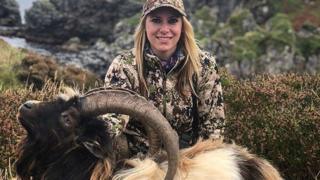Anger after 'hardcore huntress' shoots goat on Scottish island
 Image copyright
Twitter/@LSwitlyk
Image copyright
Twitter/@LSwitlyk
A Scottish government minister has called for an end to the hunting of wild goats on Islay.
Mike Russell was responding to social media posts showing American TV presenter Larysa Switlyk posing beside dead goats on the island.
Ms Switlyk, who describes herself as a "hardcore huntress", hosts the Larysa Unleashed programme.
Mr Russell, who is the local MSP for the area, told BBC Scotland that the images were "horrific".
He said he had contacted Scotland's environment secretary, Roseanna Cunningham, to call for goat hunting to be "stopped immediately" on the island.
Several tourism companies offer the chance to stalk and shoot wild goats in Islay, Dumfries and Galloway and other parts of the UK.
The animals, which have no natural predator, are classed as an invasive, non-native species in the UK, and hunting them on private land is not illegal.
Controversial culls have been carried out in some areas to reduce their numbers, while contraceptive darts have also been used to stop the animals reproducing.
In her social media posts, which were made on Tuesday, Ms Switlyk is shown wearing camouflage clothing and aiming a sniper rifle on the island.
Two photographs show her posing next to a dead goat, while another shows a dead ram.
The caption on one photograph says: "Beautiful wild goat here on the Island of Islay in Scotland. Such a fun hunt!!"
She added: "They live on the edge of the cliffs of the island and know how to hide well. We hunted hard for a big one for 2 days and finally got on this group.
"Made a perfect 200 yard shot and dropped him."
Other posts from earlier this month show her posing next to dead red deer stags at Mingary Castle in Ardnamurchan.
Speaking to BBC Scotland's John Beattie programme, Mr Russell insisted that Ms Switlyk's goat hunting was worse than the hunting of red deer, which he said was "very firmly regulated" and "you don't see people glorifying in it very often."
The Brexit secretary added: "The pictures are horrific. Obviously deer culling and deer stalking is established on the island and it's a necessary thing to do considering the lack of control of deer numbers.
"But to see people in camouflage with highly powered sniper rifles rejoicing at the killing of a goat, let alone a ram, is simply unacceptable.
"The vast majority of people would just not regard this as something that should be happening in their country.
"There has been something of an outcry already about it and as a local MSP I have now raised it with the environment minister because I think it's really undesirable and unpleasant."
Mr Russell said it was not clear whether anything could be done to stop goat hunting from happening, but he said he had a duty to raise it as "this isn't 21st Century Scotland. This isn't 21st Century Islay".
'Barbaric practice'
Ms Switlyk was also condemned by Scottish Greens MSP Mark Ruskell, who urged the Scottish government to "make it known that bloodsport participants are unwelcome to visit Scotland for the barbaric practice".
But the Scottish Country Sports Tourism group said country sports tourism was worth £155m to the Scottish economy every year.
Ms Switlyk, who is understood to have been filming in Scotland, has not yet responded to requests for comment.
The Larysa Unleashed website says the presenter "promotes the outdoor lifestyle, offering a taste of the adventure as she blossoms into a hardcore huntress.
"Along the way Larysa wants to encourage the public, especially kids and females, to go hunting and experience the great outdoors.
"Whether it's teaching them to shoot a gun for the first time, or hunting alongside her for an amazing trophy, it will be nothing less than an extreme adventure".
Feral goats are thought to have roamed parts of Scotland and the north of England for about 5,000 years, when they were introduced by Stone Age humans.
There are currently estimated to be about 3,000 animals in herds spread across the country.